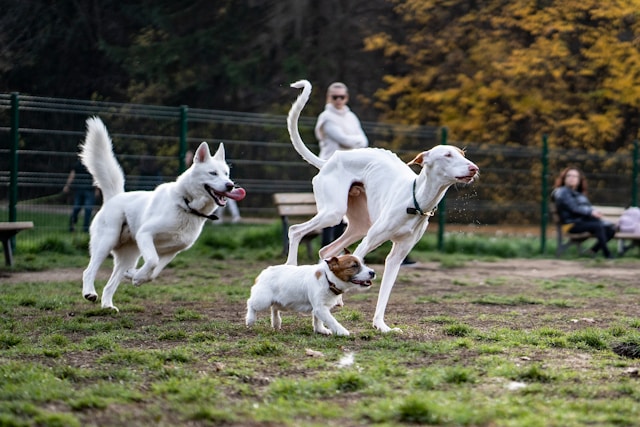Introduction
Dogs communicate primarily through body language, using their posture, facial expressions, and movements to express their feelings and intentions. As a pet owner, understanding these signals can greatly enhance your relationship with your furry friend, improve their well-being, and ensure their needs are met. In this blog, we’ll explore the key aspects of dog body language and provide insights into what your dog might be trying to tell you.
The Basics of Dog Body Language
1. The Importance of Context
Understanding a dog’s body language requires paying attention to the context in which it occurs. Factors such as the environment, the presence of other animals or people, and recent events can influence a dog’s behavior.
2. Reading Your Dog’s Entire Body
A single gesture or expression may not provide a complete picture. Always consider your dog’s entire body language, including their posture, tail position, ear orientation, and facial expressions.
Common Dog Body Language and Their Meanings
1. Tail Wagging
- Slow Wagging: Often a sign of hesitation or uncertainty. Your dog might be unsure about something or trying to gauge your reaction.
- Fast Wagging: Generally indicates excitement or happiness. The wagging might be accompanied by a relaxed body and an open mouth.
- High, Rigid Tail: A sign of alertness or potential aggression. The dog is likely feeling dominant or threatened.
- Low, Tucked Tail: Indicates submission or fear. Your dog might be feeling anxious or intimidated.
2. Ear Position
- Ears Forward: Indicates curiosity, attentiveness, or excitement. Your dog is engaged and interested in something.
- Ears Back: Can signify fear, submission, or aggression. If combined with a lowered body, it’s likely a sign of anxiety or distress.
- Ears Pinned Back: Often a sign of extreme fear or aggression. Your dog might be feeling threatened or cornered.
3. Facial Expressions
- Relaxed Mouth: Indicates contentment. A relaxed mouth with a slightly open or neutral expression usually means your dog is comfortable.
- Panting: Can be a sign of heat, stress, or excitement. Pay attention to other body language cues to determine the cause.
- Bared Teeth: May indicate aggression or a warning sign. If your dog is showing their teeth without growling or snapping, it’s often a sign that they’re feeling threatened.
4. Body Posture
- Relaxed Body: Shows comfort and ease. A relaxed stance with a loose, wiggly body often indicates a happy and comfortable dog.
- Stiff Body: Indicates tension or readiness to confront something. A stiff, rigid body may signal that your dog is feeling defensive or uncertain.
- Cowering or Lowering Body: Signifies submission or fear. Your dog might be trying to make themselves appear smaller to avoid conflict.
5. Play Bow
- Description: A play bow involves your dog lowering their front end while keeping their rear end elevated, with their tail wagging. This gesture is an invitation to play and is generally accompanied by a happy, relaxed demeanor.
6. Paw Lifting
- One Paw Lifted: Often a sign of hesitation or curiosity. Your dog might be uncertain about something or trying to get your attention.
- Pawing at You: Indicates a desire for attention or interaction. Your dog is likely seeking affection or wanting to play.
7. Nose and Mouth Licking
- Nose Licking: Can be a sign of stress, anxiety, or appeasement. Your dog might be feeling uneasy or trying to soothe themselves.
- Mouth Licking: Often a sign of submission or nervousness. Your dog might be trying to calm a situation or show that they’re not a threat.
Reading Behavioral Cues
1. Aggression
Aggressive behavior can be indicated by a combination of body language cues such as a stiff body, raised hackles, bared teeth, and growling. It’s important to assess the situation carefully and avoid confrontation.
2. Fear or Anxiety
Signs of fear or anxiety include a low, crouched body, tail tucked between the legs, and ears pinned back. Your dog might also avoid eye contact or try to hide.
3. Happiness and Contentment
A happy dog will display a relaxed body, wagging tail, and an open mouth. They might also approach you with a loose, wiggly body and engage in playful behavior.
4. Curiosity or Interest
A curious dog will have their ears perked up, eyes focused, and body slightly forward. They might also sniff around or follow the source of their interest.
How to Respond to Your Dog’s Body Language
1. Respect Their Space
If your dog shows signs of fear or aggression, it’s crucial to give them space and avoid pushing them into uncomfortable situations.
2. Provide Comfort
For anxious or stressed dogs, provide a safe and quiet space where they can retreat. Offering calming treats or toys can also help ease their anxiety.
3. Encourage Positive Behavior
Reward your dog’s positive behavior with treats and praise. This reinforces good behavior and strengthens your bond.
4. Seek Professional Help
If you’re unsure about your dog’s behavior or if they display aggressive tendencies, consult with a professional dog trainer or behaviorist for guidance and support.
Conclusion
Understanding your dog’s body language is essential for fostering a strong and healthy relationship with your furry friend. By learning to read and interpret their signals, you can better address their needs, enhance their well-being, and ensure a happy and harmonious home environment. Always observe your dog’s entire body language and consider the context to gain a complete understanding of what they are trying to communicate. With patience and practice, you’ll become more attuned to your dog’s emotions and needs, leading to a deeper and more rewarding bond.
This blog post provides an in-depth look at dog body language, offering insights into how to interpret and respond to various signals your dog may give.











Leave a Reply